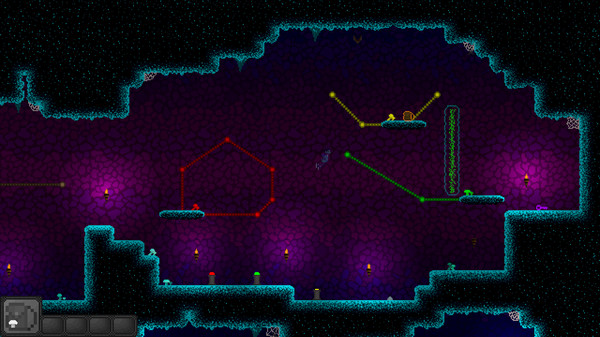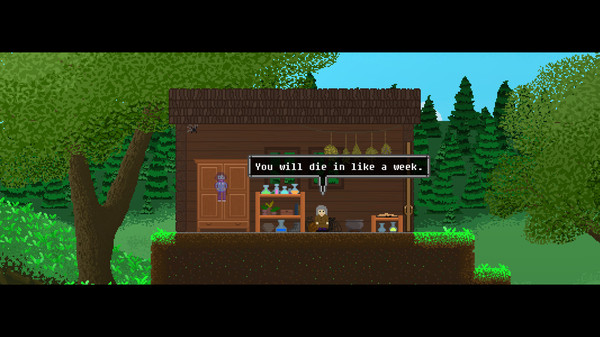Ghostory, indie studio Rigid Core’s first game, recently released on Steam, promising 29 levels of platformer puzzling and a retro, 2D pixel aesthetic. The game gets the core concept right for the most part, with a very well done central gimmick and some clever designs. Overall, though, it’s not enough to make it easy to recommend the game, as there are some substantial flaws in pacing and delivery that make it more of a chore than it should be to play.
Premise
Ghostory doesn’t take itself seriously, which is a good and bad thing (more about the bad later). It starts with you as a young man, with a considerable helping of 5 o’clock pixel shadow, running desperately through the woods as you try and outrace a pack of wolves. Eventually you get away and take a refreshing drink at a nearby lake, only to find that you’ve turned transparent upon drinking. Fortunately, there is a witch’s home nearby, and she knows the cure. Unfortunately, she just used the last of her ingredients on a traveler who passed by a few minutes before. So, you’re tasked with heading into the nearby cave to recover them for her, for without the potion, you’ll die soon. (There’s no time limit, though, so no worries there). Meanwhile, you can shift between human and ghost form at will, and you head off into the cave to try and save your life.
Gameplay
The core gameplay in Ghostory revolves around that ability to change form. By pressing Shift, you transform into a transparent form of yourself and can pass through obstacles, scope out a level, or get to a certain platform a lot faster than normal. If that sounds like it would make the game far too easy, it doesn’t. You see, you have to make it to the end of each room with your backpack—else you can’t pick up the required ingredients for the restorative potion, keys you need to unlock doors and cages, and so on. That’s where the challenge comes in. In essence, the game is more about getting your backpack to the end of each room than it is moving the character around.
Switch It Up
The puzzles you encounter in the process are varying takes on a process sequence, where you complete certain actions first in order to proceed to the next step. All take the same basic form: flip switches, move boxes, hop on moving platforms, pick up a key, unlock a cage so you can flip another switch, find another key, open a door, repeat until you get to the end of the room. If it sounds repetitive, that’s because it is after a while.
Don’t get me wrong. Some of the puzzles are quite challenging, if not as cerebral as I would have liked, and most of them are well designed. It doesn’t take long for the puzzles to become more difficult either. When you do get stuck, though, you can select the hints option from the menu, which takes you to an unlisted YouTube video posted by Rigid Core, showing you how to complete the level. However, in most cases, I sincerely wish the solutions had been a bit more involved, rather than “oh, I just move a bit faster to get to that platform” or “move this box first before I go to that switch.”

Given the nature of the puzzles, the game is best played in short bursts. But it’s not really designed for that. You only encounter save points after clearing every five rooms or so, and it’s a bit of a chore to go back through and complete puzzles you’ve already finished just because you didn’t reach the save point before life called. A related problem is the length of some puzzles.
Even early on, there are those that take a good while to complete, requiring multiple steps to get to the end and, depending on the puzzle, going old-school and punishing you by making you start over if you happen to fall at the wrong time. The challenge would be appreciated if it didn’t mean going through tedious steps just to get back to where you were and perform more tedious steps. Here is where variety would have helped make the game more enjoyable.
Some of the problems you’ll encounter aren’t really puzzle related either. For example, there are several timed switches, where you are given only so much time to get to a platform before it stops moving or disappears. The timing is a tad too short on some of these. I suspect that with a proper controller, it wouldn’t be a big deal, but playing with the keyboard makes for clunky and imprecise controls, which runs counter to the sort of precision required in jumping and general movement.
What’s In My Pocket?
There is one other problem connected to the puzzles themselves: the core concept. When your character is standing there with his hands in his sweatshirt pockets and is wearing jeans to boot, there seems little reason to place such heavy importance on moving a backpack around so you can pick up items. Hoping for logic in video games is an exercise in futility—as it should be—but a glaring flaw in the main mechanic like that is difficult to ignore.
Story Problems
What the game really needs is something to pull the player forward, providing a reason to look past these faults and push through the puzzles. The story remains pretty much the same as it starts—lighthearted, maybe a bit too flippant. It’s not bad, but there isn’t enough to give the player a reason to keep going, especially as the only story snippets you get are at the save points, when you communicate with the Witch or others via a rift in space.

The dialogue is competent, though not outstanding, with nothing to separate each character from the other. For example, the Witch, who’s supposed to be an old lady, sounds like she just finished her sophomore year in high school (which is “uhm…like” a bit off-putting). There are Steam achievements, but they seem gratuitous—getting an achievement for improvising a puzzle solution when it was the only one, for instance.
Audio-Visual
In terms of sound and visuals, the game performs much better. The 2D pixel art is lovely to look at, and despite the fact that the backgrounds get a bit old before finally changing as you progress further, the color scheme is deep and rich. There isn’t much in the way of sound, though the atmospheric undertones of the music add a nice feel to the game overall.
The Verdict
Ghostory has a very solid concept, and the developers clearly put a good amount of thought into the puzzles themselves. Some players may find the puzzles as reason enough to continue, and it might be just the thing to scratch that puzzler itch. However, the overall piece is bogged down by repetition and no real incentive to keep going. Hopefully, Rigid Core’s next outing will provide players with a more well-rounded experience.







Published: Nov 2, 2017 03:10 pm